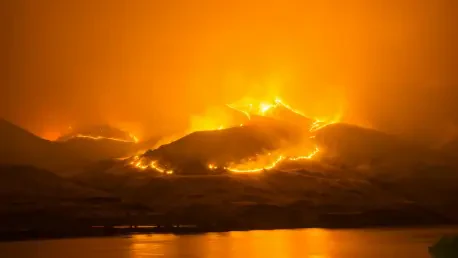What happens when a nation synonymous with rain and mist becomes a tinderbox for wildfires? In 2025, the UK is grappling with an unprecedented 700% spike in wildfire incidents compared to last year, a statistic that has sent shockwaves through communities and industries alike, forcing a reevaluation of long-held assumptions about environmental risks. Once considered an unlikely threat in this temperate climate, wildfires are now scorching landscapes and rewriting risk profiles overnight. This alarming trend has thrust the insurance sector into uncharted territory, forcing a rapid rethink of strategies to protect both policyholders and the broader economy from a fiery new reality.
A Startling Shift in the UK’s Climate Landscape
The UK has long been a land of drizzle and fog, where the idea of widespread wildfires seemed as foreign as a desert mirage. Yet, climate change has turned this perception on its head, with drier springs and blistering summers creating perfect conditions for fires to ignite and spread. The dramatic increase in incidents this year signals a profound shift, as once-green fields and woodlands transform into fuel for devastating blazes that threaten homes and livelihoods.
This surge is not merely a seasonal anomaly but a wake-up call for systemic change. Insurers, who previously viewed wildfires as a negligible risk compared to floods, now face mounting pressure to adapt. The scale of destruction, with burned areas doubling compared to any prior peak year, underscores the urgency of addressing this emerging crisis before it spirals further out of control.
Why Wildfires Have Become a Major Threat
Climate shifts have introduced a vicious cycle of wet winters fueling vegetation growth, only for scorching heatwaves to dry it out, priming the land for ignition. Spring, traditionally a time of renewal, has morphed into peak wildfire season, catching both residents and industries off guard. Rural regions and urban-fringe zones are particularly vulnerable, as fires race through dense undergrowth with few natural barriers to slow their advance.
For the insurance industry, this represents a systemic risk that extends beyond isolated property damage. Critical infrastructure, such as energy grids, faces potential cascading failures when fires disrupt power lines or utilities, amplifying economic losses. With such widespread implications, traditional risk models are proving inadequate, pushing insurers to seek innovative ways to quantify and mitigate this growing hazard.
Innovations Rising from the Ashes
The wildfire crisis has exposed significant gaps in the insurance sector’s preparedness, yet it has also ignited a wave of innovation. Underwriting, long reliant on historical data, struggles with the unpredictable nature of wildfires due to sparse records. To counter this, companies are turning to cutting-edge tools like AI-driven analytics and high-resolution mapping to assess risks based on real-time factors such as vegetation density and proximity to fire stations.
Claims processing faces its own hurdles, as wildfires often leave behind total destruction with no warning, stripping policyholders of documentation. Adjusters are adopting more flexible approaches, using drones and satellite imagery to evaluate damage in remote or hazardous areas. These technological advancements are paired with a renewed focus on empathy, recognizing the unique emotional toll of losing everything to a blaze.
Beyond individual claims, insurers are updating models to account for broader vulnerabilities, especially to heritage properties with timber frames and infrastructure networks. This could mean higher premiums or coverage limits for high-risk areas, a tough but necessary adjustment. The industry’s ability to balance innovation with practicality will be key to managing this evolving threat.
Voices Echoing the Urgency of Adaptation
Industry leaders are not mincing words about the gravity of the situation. Glyn Brookes-Humphrey of Woodgate & Clark cautions that unchecked development on natural fire breaks could turn future blazes into catastrophes, urging a reevaluation of planning policies. “Ignoring wildfire risks in land use is a gamble we can’t afford,” he emphasizes, drawing parallels to established flood zone restrictions.
Caroline Elliott-Grey of Lexis Nexis Risk Solutions highlights another pressing concern: the ripple effects on infrastructure. “A single fire can trigger cascading failures across power and utility systems, and our models must evolve to capture these impacts,” she notes. Meanwhile, adjusters on the ground share heartrending accounts of families facing total loss, a reminder that wildfire claims carry a heavier emotional weight than many other disasters, pushing for more compassionate handling.
Strategies to Build a Fire-Resistant Future
Navigating this crisis demands actionable steps from insurers and beyond. Embracing technology is paramount—AI, satellite data, and real-time visualization can sharpen risk prediction, allowing for tailored pricing in vulnerable rural and urban-edge areas. Such tools enable a more detailed understanding of where fires are likeliest to strike, helping to allocate resources effectively.
Refining claims processes is equally critical, with training in fire behavior and soft skills equipping adjusters to handle total loss scenarios with care. Deploying drones for rapid, safe damage assessments can expedite payouts, easing the burden on affected communities. Collaboration also plays a vital role, as partnerships with government and energy sectors to develop early warning systems and share data can prevent the escalation of fire events.
Finally, integrating wildfire risks into urban and rural planning is essential to avoid exacerbating exposure. Advocating for development policies that steer clear of high-risk zones mirrors successful flood prevention strategies and could save countless properties. These measures collectively offer a blueprint for not just reacting to the current surge but fortifying defenses against a warming, more volatile climate.
Reflecting on a Crisis That Reshaped Priorities
Looking back, the wildfire surge of 2025 stood as a defining moment for the UK insurance industry, revealing both vulnerabilities and the capacity for resilience. It forced a reckoning with outdated models, compelling insurers to adopt technologies and approaches that better matched the scale of climate-driven threats. The emotional scars left on communities underscored the need for a human-centered response, one that went beyond financial compensation.
The path forward demanded sustained effort—continued investment in predictive tools, deeper collaboration across sectors, and a commitment to smarter planning to curb future risks. As the smoke cleared, the lessons learned offered hope that such preparedness could shield the nation from even graver losses down the line, ensuring that this fiery chapter became a catalyst for lasting change.









